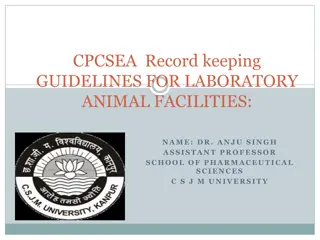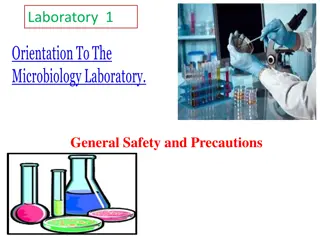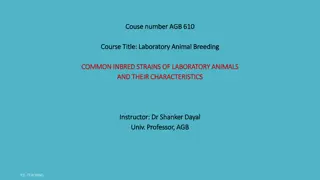Understanding Laboratory Animals and Their Classification
Laboratory animals play a crucial role in scientific research due to their physiological similarity to humans. Common types include mice, rats, hamsters, guinea pigs, rabbits, and monkeys. They are classified into conventional and gnotobiotic animals based on their microbial status. Specific pathogen-free and germ-free animals are important for studying microbiology, nutrition, and physiology. Each species, such as mice, rats, and guinea pigs, has specific characteristics that make them valuable for research purposes.
Download Presentation

Please find below an Image/Link to download the presentation.
The content on the website is provided AS IS for your information and personal use only. It may not be sold, licensed, or shared on other websites without obtaining consent from the author. Download presentation by click this link. If you encounter any issues during the download, it is possible that the publisher has removed the file from their server.
E N D
Presentation Transcript
Laboratory Animals Dr. R. R. K. Sinha
An animal which has more or less similar physiological and body composition with various biological systems as human beings, which are tiny, easy to handle, less expensive and co-operative are called as laboratory animals. Types of Laboratory animals: Mice, Rats, Hamster, Guinea Pigs, Rabbits, Monkeys and Transgenic Fly are popular Laboratory animals.
Classification of Laboratory animals: Conventional animals: - Animals derived and grown in general environment but free from diseases communicable to human like mycobacteria, Dermatophytic fungi,Pasteurella and Sarcopts Scabiei. Gnotobiotic animals:- Animals with known microbes such as virus, bacteria, fungi and protozoa is said to be gnotobiotic animals. This animal has to be bred in controlled environment in the equipment called isolator. They are foundation stocks for producing specific pathogen free animals. Gnotobiotic rats & mice are used to study carcinogenesis,immunology,toxicology,nutrition etc.
Specific Pathogen FreeAnimals:- An animal which is made free from specific or particular microbe is known as SPF animals. Germ free animals:- An animal which don t have any demonstrable microbe is known as germ free animal. This can be achieved by killing the mother with cervical dislocation and removing the foetus by hysterectomy without any anaesthetic in an isolator. Young ones must be reared in a isolator in germ free environment. The feed and water also must be provided after sterilisation. These animals are useful: To study role of microbes in nutrition. To study physiology without infection. To conduct biological,toxicological & microbiological assays.
Salient characteristics of Laboratory animals Mice:- They are smaller in size, early puberty, high fecundity, short gestation, high position in evolutionary scale. Due to these specialties about 60-70% laboratory animals are used as mice.
Rat:- Nearly 2-3 times bigger in size than mice, short gestation, prolific breeder,early puberty and high fecundity.
Guinea Pig:- It is prolific breeder,easy to rear and breed in captivity. Gestation period is comparatively little bit longer than Rat & Mice. It needs supplementation ofVit.C in the diet and More susceptible toT.B.&Anaphylactic shock.
Hamster: - Syrian and Chinese are two popular varieties of hamster used in various research specifically Riboflavin andVit.E deficiencies. Chinese hamster are commonly used in research on diabetes due to high incidence of diabetes mellitus in them. It has low (22) chromosomal No. Due to which they are useful in cytological study,tissue culture,genetics & radiation research.
Transgenic Fly:- These flies bred quickly and have short life time of about 15 days. To carry out biological assay in fly is much cheaper as compared to other laboratory animals.
Difference between Rat and Mice: Rat Mice Fur of rat is coarse. Fur is Smooth Tail of rat is thicker and well serrated (notches on edge) Thinner and non-serrated Skin of rat is thick Thin Rat is bigger in size and heavy in weight Mice is smaller and light in weight
Biological & Physiological data of laboratory animals: Parameters Mice Rat Guinea Pig Hamster Syrian/Chines e 20 Rabbit Birth Weight (gm) 1-1.5 6-7 70-100 50-70 Body weight (adult gm) Daily feed consumpt.(gm) Age of first mating (M) Age for experiment(M) Heart rate (beat/min.) Respiration rate /min. Sex ratio (Male : Female) 30-40 250 800 80-90/35-40 1500-5500 5-6 15-20 45-50 10-15/10 200-250 1.5-2 2.5-3 3 2-3/2-3 6-7 45(days) 1.5 3 1/1 6 330-750 310-500 250-400 315-410/310- 400 35-130/30-125 150-300 85-230 70-180 70-110 40-60 1:3 1:5 1:6 1:1/1:1 1:1
Parameters Mice Rat Guinea Pig Hamster Syrian/Chines e Rabbit Blood Volume (% of Body Wt.) 7-10 5-7 6-12 6-9/6-10 5-8 Life span (Years) 1.5-2.5 2-3 3-5 2-3/2-3 5-6 Gestation period (Days) 20-21 21-22 65-67 16/21 31-32 Litter size 7-12 8-10 3-4 5-7/4-5 6-8 Age at Weaning (Weeks) 3 3 2-3 3 /3 7 Litter/year 8-10 7 4-5 10/7 4-5 Rest period for females in between 2 mating(days) 15 15 15 18/15 20 No.Of pairs of mammary gland 5 5 1 6-7/4 3-4
Housing Laboratory animals require elaborated housing with adequate ventilation and space to move. The house should provide protection from weather, predators, mosquitoes and insects. Laboratory animals can be housed on floor or in cages in groups in the house. The space requirement mostly depends on body weight and size. Formula to calculate floor space for laboratory animals is: A=n (3W+5 W) in square inches. A =n (0.7W +6 W ) in square cm. Where A or A = Floor space W or W =Wt. Of animals(W= Wt. In ounce and W = Wt. In grams)and n= no. Of animals.
Floor space requirement: Area (cm2) Animal Height of cage (cm) Mice 38-99 17.5 Rat 110-260 22.5 Hamster 64-125 22.5 Guinea Pig 270-650 35
Site of housing:- Higher elevation Minimum access to visitors Minimum noise disturbance Separate from main biological/Immunological production unit Away from polluted area. Types of housing:- 1. Non-air conditioned 2. Air conditioned Non-air conditioned:- The direction of air flow should be taken into consideration while constructing those houses. The air flow should not directly enter the entrance of house.The house should have 2 corridors.
Clean corridor: - This is place in front of animal room and used- To bring in sterile food/feed. To take in autoclaved cages. To take bedding materials in the house. A foot dip with antiseptic/disinfectant solution be provided at the entry of the clean corridor which facilitates reduction of microbes infiltration in house. The door of entry should open outside so that hot and light air will rush outside after opening the door, which help in checking the infiltration of outside infection in the house. The house must be free from rodents as well as insects like mosquitoes,cockroaches,bugs,flies etc. a.
b. Dirty corridor: - This is placed at backside of animal house and used To remove the garbage by having a washing room. To check contamination of incoming food/feed by removing garbage by separate outlet. To prevent direct cold drift or entry of sunlight in animal rooms.
Housing Standards: Mice: 3.5x 4.5 m i.e.15.75m2room for 200-300 mice in cages on racks. Cage size:25cm Length x 15cm width x 22.5cm height Capacity:4 adults mice or 10-12 weaners. Rat: Cage size:40-45cm length x 25-30cm width x 37.5cm height. Capacity:2 females + 1 male. Hamster: Cage size:40-45cm length x 25-30cm width x 37.5cm height. Capacity:2 females + 1 male. Guinea Pig: Cage size:0.91m length x 0.45m width x 0.45m height. Capacity:2 females + 1 male.
Strains and Breeding of Laboratory animals Mice: The common strains are Swiss Albino, Kausali, NIN, CBA, C-57, Bulb-S,CH-3 etc.SwissAlbino is most popular. Rat: The rat has blocky body with comparatively rough hair, long pointed snout,prominent long ears and sharp teeth. The body length is around 14-16cm,tail is 16-20cm. Adult weight 100-250gm. The common strains are- Wister,Sprague,Dawley,Charles Foster and Long Evans. Hamster: Syrian and Chinese are two popular strains. They have chunky body with short legs, a fluffy tail, loose skin with dense,short and soft fur. The front legs have four toes whereas hind legs possess five toes.
Adult hamster is 16cm in length and weigh 90-125gm. The Chinese hamster are only 9cm in length weighing 55gm. Hence also known as Dwarf hamster. Chinese hamster have dorsally grey colour with black strip in the centre. Syrian hamster are golden brown dorsally with little black ventrally. Guinea Pig: Peruvian,English andAbyssinian are popular strains. They are short rodents without tail. Head is blunt and rectangular.The neck is thick and so short merged with body. The hind legs are longer than forelegs. The weight of male is 800-1600gm and in females 700-1300gm.
Transgenic Fly:- This is a new fruit fly developed by L.S.Shashidhara and Poonam Bhandari at Centre for Cellular and Molecular Biology (CCMB) at Hyderabad through genetic engineering in 2000.
Breeding and Productive features of Lab. Animals Mice and Rat: Nature:- Prolific breeder Puberty:- 4 to 6 weeks Mating:- 8 to 9 weeks,early mating reduces fertility. Estrous duration:- 4 to 5 days. Gestation period:- 20 to 22 days. Birth weight of young ones:- 1 to 1.5gm Litter size:- 10 to 12 Weaning weight:- 10 to 12gm and age 21 days. Detection of successful mating: Presence of sperm in vagina smear or copulatory plug (solidified semen) in vagina.
Lee boot effect:- When large group of females are housed together they go into anestrous by due pseudopregnancy which is known as lee boot effect. Whitten effect:- When such females are housed again with male, within 72 hours they will exhibit regular estrus,which is called asWhitten effect.
Hamster: Puberty:- 4 to 6 weeks. Mating age:- 8 to 12 weeks. Weight at mating:- Syrian- 80 to 90gm Chinese- 35 to 40gm Estrus duration:- 4 to 5 days. Mating:- Hand mating is followed. Gestation period:- 16 to 18 days. Litter size:- 5 to 7 Weaning age:- 20 to 25 days and weight 15gm. Male and female housed in separate quarters, brought together only at the time of mating and separated again immediately after mating, otherwise female may cause serious injuries to tail and testes of male.
Estrus sign: - Stringy, translucent mucus is extruded initially turning into creamy white discharge in later period with odour. Well receptive female exhibits (Crouching with hind quarters raised). Mating takes usually on 4thday. Guinea Pig: Puberty:- 4 to 5 weeks. Mating age:- 9 to 11 weeks. Weight at mating:- Male- 900 to 1500 gm Female- 700 to 1300gm. Estrous sign: - Hip swaying, mounting activity, unsteady movements. Mating:- Polygamous Furrowing: - Communal i.e., group of females farrows in common pen. typical lardosis posture
Gestation: - 60 to 75 days. Birth weight: - 45 to 50gm. Litter size: - 5 to 6. Weaning weight: - 160 to 230gm.
Breeding Methods As per utility of animals and facilities available breeding methods is recommended. 1. Monogamy: - Involves pairing of single male and female. Method is useful for inbreeding of stocks and usually pair is kept for life long. 2. Polygamy or Harem method: - This consists of keeping together one male and more than one females in one cage. Normal male to female ratio recommended is 1:2-6 (Mice & Rat),1:10 (Guinea Pig),1:7 (Hamster). 3. Continuous mating: - Mating occurs immediately or within few hours after parturition. In inbred mice in monogamous mating males are not separated and mating is continuous. ,
Discontinuous mating: - Female is separated from male sometime before parturition, to avoid post-partum mating. Mating is advocated after lactation i.e.During post lactation oestrous. Breeding systems:- 1) Inbreeding 2) Out breeding 3) F1 generation breeding: - To reduce the biological diversity in out bred animals and check the inbred drawbacks, it is better to select F1 (first felial) generation of progeny have more homozygosity for breeding than two heterogenous parents. F1 generation also has hybrid vigour due to optimum heterozygoes state and have equal homozygosity. Hence can be very well used to conduct biological & immunological research. 4.
Selection of laboratory animals for breeding: Animals selected for breeding should have good parental record like production,progeny,litter size and mothering ability. Animals must be physically fit and healthy. Animals which is bigger in litter be preferred. If litter consists more males and less female, the whole litter should be rejected. Animals exhibiting vices must be rejected. There should not be any discharge form ear,nose and eyes. The animal to be selected should be alert,vigorous, clean and off standard size.
Handling, Identification and feeding of lab. animals Laboratory animals are mostly smaller in size and more delicate, so handling is very important. Gentle handling is the best way to obtain real and correct experimental results. Purpose of handling: 1. Housing 2. Weighing 3. Inoculation & sample collection 4. Inspection to note body changes 5. Marketing and transport.
Methods of handling: Mouse: - Mouse should be quickly and firmly picked by grasping base of tail to lift slightly upward. For examination, grasp the scruff at the base of neck with thumb and index finger by one hand (mostly left hand). Support tail of animal with 4thor 5th finger. Rat: - Rats should not be hold for longer time with tail grip because they get irritated and try to bite. After grasping by one hand,immediately grip rat with other hand by placing 2ndand 3rd finger on either side of mandible through the neck,whereas 4th& 5thfinger should be placed on chest. Hamster: - The hamster must be picked up confidently and gently because improper handling tends to bite. It should be grasped with large pinch on the scruff with palm and other fingers to hold.
Guinea Pig: - Guinea pigs can be lifted by placing thumb and other fingers over either sides of neck by one hand and then support body with other hand under the caudal end of animal.
Identification of laboratory animals: 1. Staining: - Painting the animal with dyes like crystal violet, carbol fuschin etc. can be conveniently used for marking. Staining on skin coat on small area will easily visual. 2. Tagging/Branding: - Rabbits and Guinea pigs can be tagged. Aluminium tags with embeded numbers are normally used. 3. Tattooing: - usually carried on ears, foot, shoulders or hip for identification. 4. Notching: - Cutting ears in specific shape at particular place in the form of notch is also used as identification marks in rats and mice. ear
Feeding of laboratory animals: Feed/food for lab.Animals should not be stored for longer duration because it looses its nutritive value and leads to reduce acceptability. Feeding raw materials: Rodents are naturally grain eater, hence their feed formulation should consist of large quantity of grains,seeds and nuts. Usually more than one grains are mixed together to compensate deficiency in one grain by other. Common raw materials used for preparing feed are crushed maize, whole wheat, barely, oat, sunflower seed, powdered millets, gram flour, salt, vitamin and mineral mixture etc. can be used.
Greens like succulent grasses, Lucerne or berseem along with vegetables are fed in Guinea pig and rabbits. Feed form: Pellets are preferred instead of mash because mash get soared faster with difficulty of storing as well as it is messy, unhygienic and laborious to prepare. Pellets are commercially available for feeding lab.Animals.
Feeding of mice and rat: These animals take small bites of food or pellets. They pull the pellets through wire mesh, hold in front leg and then eat. Their food should contain 16 to 20 % protein,4 to 5% fat and 45 to 50% carbohydrate. Daily requirement:Rat 15gm and Mice 6gm. Raw materials Wheat flour Gram flour Skimmed milk powder Refined oil Salt Vitamins and Minerals Total Proportion of mixing (%) 75.0 10.0 10.0 10.0 1.0 3.5 100.0
Feeding of Hamster: Hamster have check pouch. They eat faster and store in the pouch. Then they go to corner and chew the stored food slowly. Their feed consists of 16 to 20% protein, 4 to 5% fat and 45 to 50% carbohydrate. Daily feed requirement- 15gm. Feeding of Guinea Pig: Green grasses, leaves and vegetables chewing is main features of guinea pig feeding.
Raw materials Proportion of mixing (%) Wheat bran 20.0 Whole grams 10.0 Carrots or Cabbage 10.0 Lucerne 60.0 Total 100.0 Nutrient composition: 16 to 25% protein, 4 to 5% fat, 45 to 50% carbohydrate and 10% fibre. Specially required nutrient is Vitamin C. Hence it should be supplement either through feed or water @ 250mg/Liter. Daily feed requirement- 60 to 70gm.
Disease and health care Like other animals Laboratory animals are susceptible to many viral, bacterial, mycotic, parasitic and external pest infection. The disease may emerge and appear in the form of morbidity, mortality or outbreaks. Diseases of Mice: Bacterial:- Salmonellosis: causative agent are S. Typhimurium and S. Enteritidis. Pasteurellosis: Causative agent are P. Pneumotropica, P. Muricida and P.Pestis. Mouse Septicaemia: Causative muriceptica. Tyzzer s disease:caused by Bacillus pilliformis. agent is Erysephalothrix
Viral disease:- Pox Lymphocytic choriomeningitis Tumours Mycotic infections:- Mycoplasma pulmonis, Arthritidis and Murolyticum causes chronic pneumonia,abscesses in joints and meningitis. Diseases of Rats:- Bacterial: Salmonellosis, Leptospirosis, Pasteurellosis are the bacterial infections. Viral:Encephalomyocarditis and Lacrimal duct infection.
Parasitic infections: Sarcosporidiosis Entamoeba and Eimeria spp. Toxoplasma gondii External parasites:Lice and Mange. Diseases of Hamster: Hamster are mostly free from spontaneous diseases but Salmonellosis and Mange are common. Viruses like Adenovirus produces cancer and Coxsackie-B virus leads to diarrhoea. Canabolism: This is a managemental disorder resulting into destroying of young ones by mother due to human smell after handling.The following care should be taken:-
Rub the hands with bedding materials to remove human smell. First separate mother from young ones from cage. First put young ones in cage by rubbing them with bedding materials or cloth. Diseases of Guinea Pigs:- Guinea pigs are also relatively disease free animals but Salmonellosis, Streptococcal pneumonia and Pasteurellosis are common bacterial diseases.
Disease prevention and control through sanitation:- Drinking water provided to lab. Animals should be purified, filtered & treated. Instead of using usual sanitizer, water is treated with Hcl at the dose level of 1ml/litre. The bedding materials used should be properly sterilized and be changed once or twice a week. Equipments like cages, feeders and waterers should also be sterilized. The feed/food supplied to lab animals should be balanced and sterilized. The house must be cleaned daily with disinfectants like phenyl, lysol etc. Entry of insects, mosquitoes, flies etc. must be prevented in lab. Animal houses.
Isolation of diseased animals and appropriate timely treatment with special care for cleaning & disinfection of houses should be done. Quarantine for new entries with 2 or 3 weeks observation period to check biological transmission of diseases should be done.
Transportation of laboratory animals Laboratory animals represent only a small fraction of animals moved in commerce and they differ from many in usually having a more defined health status. The objective is to move them in a manner that does not jeopardise their wellbeing or health status. Minimises controllable sources of stress and ensures their safe arrival at their destination. The type of journey, its duration, the physical environment during carriage, the design of the container, along with other factors influences the animals safety and wellbeing during the journey.
General requirements: Animal transportation includes the entire period from packing, through dispatch, carriage and receipt by the consignee to the unpacking of the animals at their final destination.It is important during the transportation process: that appropriate containers be used, constructed of strong, durable materials which meet or exceed all national and international guidelines. that the animals and their shipping containers be protected from adverse weather conditions such as precipitation, direct sunlight and high winds which can affect the ambient conditions within the container or the security of the container.
that the animals be provided with an adequate supply of fresh or conditioned air that provides for their thermoregulatory, respiratory and metabolic needs. that the animals be protected from exposure to extremes environmental conditions,especially high temperatures. that the animals be prevented from escaping,or from falling out of the container, or extending appendages outside the container, or from experiencing other conditions that result in physical harm, including illness,injury or death. that factors that may cause animal discomfort or stress during the journey are recognised and,where possible,minimised.



























